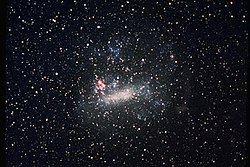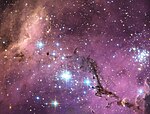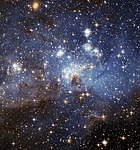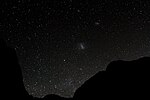Stora magellanska molnet
| Stora magellanska molnet | |
 Stora magellanska molnet | |
| Observationsdata | |
|---|---|
| Stjärnbild | Svärdfisken/Taffelberget |
| Rektascension | 05t 23m 34.5s[1] |
| Deklination | -69° 45′ 22″[1] |
| Avstånd | 162 980[2] ljusår |
| Typ | SB(s)m[1] |
| Skenbar storlek | 10,75° × 9,17°[1] |
| Skenbar magnitud | 0,9[1] |
| Andra beteckningar | |
| LMC, ESO 56- G 115, PGC 17223,[1] Nubecula Major | |
| Se även: Galaxer, Lista över galaxer | |
Stora magellanska molnet är en oregelbunden dvärggalax i stjärnbilderna Svärdfisken och Taffelberget. Den är en av Vintergatans satellitgalaxer[3], och ingår i Magellanska molnen tillsammans med Lilla magellanska molnet.
Utforskning
Persiska astronomen ’Abd al-Rahman al-Sufi (senare känd som "Azophi"), beskrev Stora magellanska molnet i sin Stjärnbildernas bok, utgiven cirka 964 e.Kr.[4][5]
Nästa kända västerländska observation gjordes 1503–1504 av Amerigo Vespucci i ett brev om sin tredje resa till sjöss.[6]
Ferdinand Magellan siktade Stora magellanska molnet 1519 då han var ute och seglade, och Stora magellanska molnet blev allmänt känt i västvärlden, och är namngivet efter honom.[5]
2006 menade man, efter studier med Hubbleteleskopet, att Magellanska molnen rör sig för snabbt för att kretsa kring Vintergatan.[7]
Objekt i Stora magellanska molnet
Inom molnet finns Tarantelnebulosan, det mest aktiva stjärnbildningsområdet i den lokala galaxgruppen. Inuti den finns t.ex. supernovaresten NGC 2060. Även supernovaresterna SN 1987A finns i utkanten av Tarantelnebulosan.
I galaxen finns också stjärnan HD 33579, en gulvit hyperjätte som är en av mycket få kända stjärnor som befinner sig i området "Yellow Evolutionary Void" i Hertzsprung-Russell-diagrammet.
NGC 1748 är en emissionsnebulosa i Stora magellanska molnet. Andra emissionsnebulosor är NGC 1763 och NGC 2080.
Galaxen innehåller flera klotformiga stjärnhopar: NGC 1466, NGC 1644, NGC 1754, NGC 1783, NGC 1978, NGC 1806, NGC 1831, NGC 1846, NGC 1854, NGC 1860 NGC 1866, NGC 1916, NGC 1939 och NGC 1953.
Öppna stjärnhopar i galaxen är NGC 1652, NGC 1711, NGC 1751, NGC 1755, NGC 1756, NGC 1928, NGC 1983, NGC 1984, NGC 1856, NGC 2010, NGC 2011, NGC 2100 och NGC 2107.
Bildgalleri
- LHA 120-N11.
- LH 9, ett område I Stora magellanska molnet där det föds mycket stjärnor
- SNR B0544-6910 i Stora magellanska molnet
- SNR 0543-689
- DEM L 159 och de två stjärnhoparna KMHK 840 (uppe till vänster) och KMHK 831 (nere till höger)
- Översiktsbild som visar Stora och Lilla magellanska molnet på södra stjärnhimlen
- Stora magellanska molnet i infrarött ljus
Referenser
- Den här artikeln är helt eller delvis baserad på material från engelskspråkiga Wikipedia, 15 september 2013.
Noter
- ^ [a b c d e f] ”NASA/IPAC Extragalactic Database”. Results for Large Magellanic Cloud. http://nedwww.ipac.caltech.edu/. Läst 3 november 2013.
- ^ G. Pietrzyński, D. Graczyk, W. Gieren, I. B. Thompson, B. Pilecki, A. Udalski, I. Soszyński (2013). ”An eclipsing-binary distance to the Large Magellanic Cloud accurate to two per cent”. Nature 495: sid. 76–79. doi:. http://www.nature.com/nature/journal/v495/n7439/full/nature11878.html. Läst 3 november 2013.
- ^ Implications of recent measurements of the Milky Way rotation for the orbit of t
- ^ ”Observatoire de Paris (Abd-al-Rahman Al Sufi)”. http://messier.obspm.fr/xtra/Bios/alsufi.html. Läst 19 april 2007.
- ^ [a b] ”Observatoire de Paris (LMC)”. http://messier.obspm.fr/xtra/ngc/lmc.html. Läst 19 april 2007.
- ^ ”Observatoire de Paris (Amerigo Vespucci)”. http://messier.obspm.fr/xtra/Bios/vespucci.html. Läst 19 april 2007.
- ^ Magellanic Clouds May Be Just Passing Through January 9, 2007
Källor
- Buscombe, William, Astronomical Society of the Pacific Leaflets, "The Magellanic Clouds" (1954)
Externa länkar
 Wikimedia Commons har media som rör Stora magellanska molnet.
Wikimedia Commons har media som rör Stora magellanska molnet.- SU Astronomiska termer - M
| |||||||||||||||||
| |||||
|
Media som används på denna webbplats
Nearly 200 000 light-years from Earth, the Large Magellanic Cloud, a satellite galaxy of the Milky Way, floats in space, in a long and slow dance around our galaxy. As the Milky Way’s gravity gently tugs on its neighbour’s gas clouds, they collapse to form new stars. In turn, these light up the gas clouds in a kaleidoscope of colours, visible in this image from the NASA/ESA Hubble Space Telescope.
LH 95 stellar nursery in the Large Magellanic Cloud
This image shows the Large Magellanic Cloud galaxy in infrared light as seen by the Herschel Space Observatory, a European Space Agency-led mission with important NASA contributions, and NASA's Spitzer Space Telescope. In the instruments' combined data, this nearby dwarf galaxy looks like a fiery, circular explosion. Rather than fire, however, those ribbons are actually giant ripples of dust spanning tens or hundreds of light-years. Significant fields of star formation are noticeable in the center, just left of center and at right. The brightest center-left region is called 30 Doradus, or the Tarantula Nebula, for its appearance in visible light. The colors in this image indicate temperatures in the dust that permeates the Cloud. Colder regions show where star formation is at its earliest stages or is shut off, while warm expanses point to new stars heating surrounding dust. The coolest areas and objects appear in red, corresponding to infrared light taken up by Herschel's Spectral and Photometric Imaging Receiver at 250 microns, or millionths of a meter. Herschel's Photodetector Array Camera and Spectrometer fills out the mid-temperature bands, shown here in green, at 100 and 160 microns. The warmest spots appear in blue, courtesy of 24- and 70-micron data from Spitzer.
Författare/Upphovsman: ESO, Licens: CC BY 3.0
Young supernova remnant, B0544-6910 located in the South-East of the ringshaped nebula DEM L 299 in the Large Magellanic Cloud. The sky field measures 3.7 x 3.6 arcmin. North is up and East is left.
Författare/Upphovsman: Markrosenrosen, Licens: CC BY-SA 3.0
large and small Magellanic Cloud from New Zealand
Författare/Upphovsman: ESO, Licens: CC BY 3.0
This is a bright, compact nebula that is located on the North-Western rim of the ringshaped nebula DEM L 299. It is known as SNR 0543-689 and it is the remnant of a more recent supernova explosion. The sky field measures 3.6 x 3.5 arcmin. North is up and East is left.
Författare/Upphovsman: ESO, Licens: CC BY 3.0
The ionised region DEM L 159 and two clusters with hot stars named KMHK 840 (top left) and KMHK 831 (bottom right).
Image of the Large Magellanic Cloud and Supernova 1987A taken by the Kuiper Airborne Observatory (NASA 714) during its New Zealand deployment in 1987.














